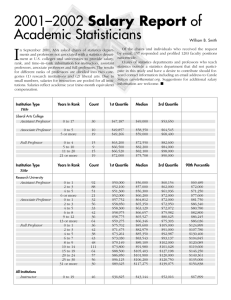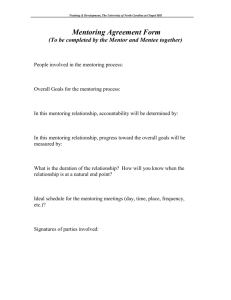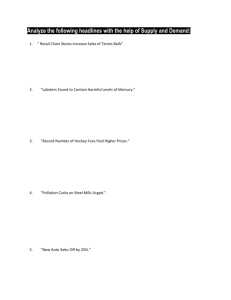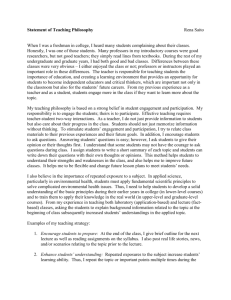UD-ADVANCE Executive Summary on the 2014 Study of Faculty Worklife
advertisement
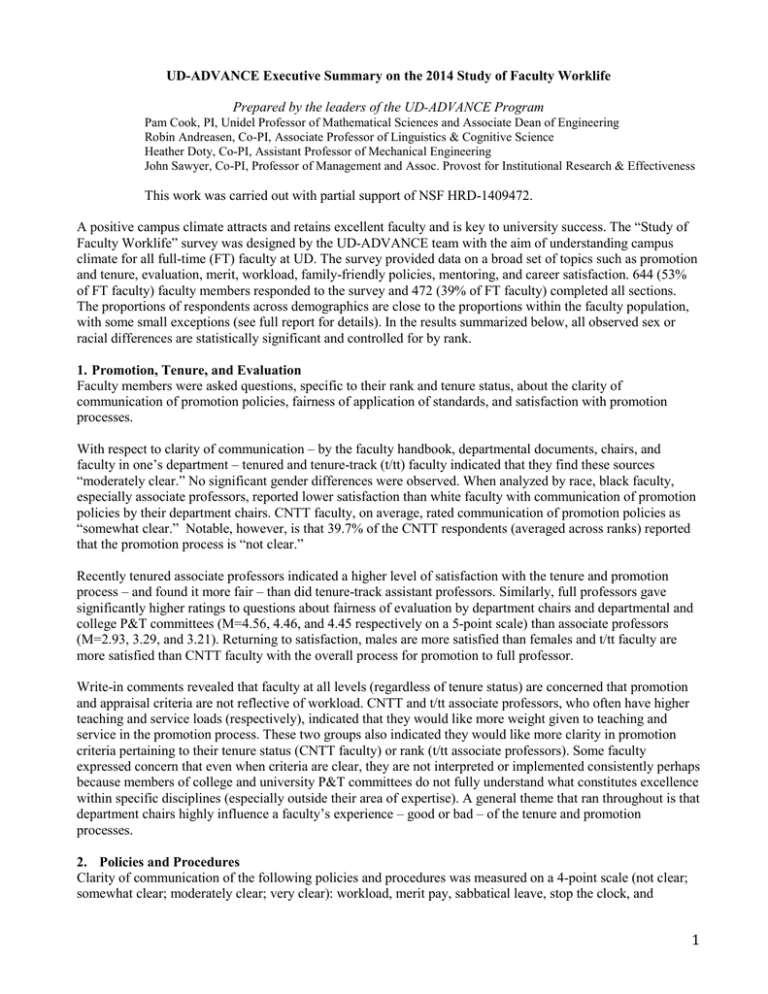
UD-ADVANCE Executive Summary on the 2014 Study of Faculty Worklife Prepared by the leaders of the UD-ADVANCE Program Pam Cook, PI, Unidel Professor of Mathematical Sciences and Associate Dean of Engineering Robin Andreasen, Co-PI, Associate Professor of Linguistics & Cognitive Science Heather Doty, Co-PI, Assistant Professor of Mechanical Engineering John Sawyer, Co-PI, Professor of Management and Assoc. Provost for Institutional Research & Effectiveness This work was carried out with partial support of NSF HRD-1409472. A positive campus climate attracts and retains excellent faculty and is key to university success. The “Study of Faculty Worklife” survey was designed by the UD-ADVANCE team with the aim of understanding campus climate for all full-time (FT) faculty at UD. The survey provided data on a broad set of topics such as promotion and tenure, evaluation, merit, workload, family-friendly policies, mentoring, and career satisfaction. 644 (53% of FT faculty) faculty members responded to the survey and 472 (39% of FT faculty) completed all sections. The proportions of respondents across demographics are close to the proportions within the faculty population, with some small exceptions (see full report for details). In the results summarized below, all observed sex or racial differences are statistically significant and controlled for by rank. 1. Promotion, Tenure, and Evaluation Faculty members were asked questions, specific to their rank and tenure status, about the clarity of communication of promotion policies, fairness of application of standards, and satisfaction with promotion processes. With respect to clarity of communication – by the faculty handbook, departmental documents, chairs, and faculty in one’s department – tenured and tenure-track (t/tt) faculty indicated that they find these sources “moderately clear.” No significant gender differences were observed. When analyzed by race, black faculty, especially associate professors, reported lower satisfaction than white faculty with communication of promotion policies by their department chairs. CNTT faculty, on average, rated communication of promotion policies as “somewhat clear.” Notable, however, is that 39.7% of the CNTT respondents (averaged across ranks) reported that the promotion process is “not clear.” Recently tenured associate professors indicated a higher level of satisfaction with the tenure and promotion process – and found it more fair – than did tenure-track assistant professors. Similarly, full professors gave significantly higher ratings to questions about fairness of evaluation by department chairs and departmental and college P&T committees (M=4.56, 4.46, and 4.45 respectively on a 5-point scale) than associate professors (M=2.93, 3.29, and 3.21). Returning to satisfaction, males are more satisfied than females and t/tt faculty are more satisfied than CNTT faculty with the overall process for promotion to full professor. Write-in comments revealed that faculty at all levels (regardless of tenure status) are concerned that promotion and appraisal criteria are not reflective of workload. CNTT and t/tt associate professors, who often have higher teaching and service loads (respectively), indicated that they would like more weight given to teaching and service in the promotion process. These two groups also indicated they would like more clarity in promotion criteria pertaining to their tenure status (CNTT faculty) or rank (t/tt associate professors). Some faculty expressed concern that even when criteria are clear, they are not interpreted or implemented consistently perhaps because members of college and university P&T committees do not fully understand what constitutes excellence within specific disciplines (especially outside their area of expertise). A general theme that ran throughout is that department chairs highly influence a faculty’s experience – good or bad – of the tenure and promotion processes. 2. Policies and Procedures Clarity of communication of the following policies and procedures was measured on a 4-point scale (not clear; somewhat clear; moderately clear; very clear): workload, merit pay, sabbatical leave, stop the clock, and 1 parental and family leave. For each of these policies, faculty ratings fell between “somewhat clear” and “moderately clear.” When broken down by tenure status, CNTT faculty rated clarity of communication lower than t/tt faculty for each policy. Of the above policies, ratings for clarity of communication of stop-the-clock came out the lowest. Importantly, nearly 30% of t/tt faculty rated UD’s stop-the-tenure-clock policy as “not clear.” Of those eligible to stop the clock (~52% of respondents), roughly 35% reported that they did not feel encouraged by their chairs or by faculty to do so. A similar result was found with respect to family leave policies. Nearly 40% of the faculty report “I don’t know” about UD’s family leave policies. In the write-in comments, respondents expressed concerns not only about lack of clarity in communication but also about fairness and consistency of policy implementation. Special attention was given to stop the clock and spousal hiring policies. 3. Work Satisfaction and Climate Respondents were asked to indicate their level of satisfaction with professional experiences at UD (experience of community, of collegiality, in primary unit, career progression and teaching, service and loads). Aggregated data indicated that, overall, faculty are satisfied with their professional lives. Disaggregated data, however, indicated areas of disparity. CNTT faculty, for example, indicated lower overall job satisfaction than did t/tt faculty. Associate professors (regardless of tenure status) indicated lower satisfaction with their service and teaching loads than did full professors – and were less satisfied with their career progression than assistant professors. Female faculty of all ranks reported lower satisfaction than male faculty with teaching and service loads. Black faculty indicated less satisfaction than non-black faculty with their “experience of collegiality” and their “overall experience” in their primary units. In response to questions pertaining to interactions with chairs and with colleagues, black faculty indicated less satisfaction than did non-black faculty. They also gave lower scores than white faculty to chair leadership and respectfulness; reported having less voice in departmental affairs; rated their colleagues lower on giving and receiving feedback; and indicated that they are less comfortable raising work-family issues among their colleagues. Clearly these are significant issues that need to be explored further and addressed. Write-in comments were clustered around three main themes: Resources and Budgeting: Faculty expressed concerns about shrinking resources and growing workloads. They reported feeling over-stretched by increased demands for grant dollars, high-visibility research output, increased teaching loads (larger classes, fewer TAs) and advising duties -- combined with a decrease in resources and rewards. Faculty stated that they would like more transparency surrounding money flow and RBB. Administrative Structuring & Communication: Faculty commented on the rapid growth in administrative positions, reported feeling separated from the higher administration and university governance, and expressed a sense that faculty research is little supported, appreciated, or rewarded on campus. They indicated that they would like increased two-way communication and interaction between faculty and the higher administration (deans, provosts, the president) and would like more involvement in policy formation and decision-making. Climate: Faculty expressed concerns about the sense of community on campus. Many reported feeling isolated or silo-ed and would like more intellectual exchange and opportunities to gather informally with colleagues on campus. 4. Diversity In addition to measuring overall climate, the survey asked respondents to rate the climate for diversity within their college and department on a five-point scale (poor; fair; good; very good; excellent). Results indicated that 2 faculty perceive the overall climate – as well as the climate for women, for faculty of color, and for LGBT faculty – as “good.” However a closer look at the data reveals a somewhat more complicated story. Men and women had different views on the climate for women within departments and at the college level: women rated these climates significantly lower than did men. Likewise, faculty of color rated the race/ethnicity climate within departments and at the college level significantly lower than did white faculty. Faculty members were asked questions about UD’s commitment to policies on diversity. On average, black faculty and women rated UD’s commitment significantly lower than did white faculty and men, respectively. Clearly white and male faculty are less sensitive to the issues of diversity than their underrepresented and female colleagues, who more likely experience the effects of negative climate for diversity. 5. Mentoring When survey respondents were asked about formal and informal mentoring (within their primary unit, within UD, and outside UD), results indicated a need for more formal mentoring. Only a quarter of respondents received formal mentoring within their primary unit; 11% received formal mentoring within UD but outside their primary unit. When sorting by racial and ethnic group, black and Hispanic respondents reported receiving more formal mentoring outside their department at UD than did white faculty. The story with respect to informal mentoring is better. Almost 60% reported receiving informal mentoring within their unit and 34% reported receiving informal mentoring within UD. Yet improvement is still needed. Assistant professors received more formal and informal mentoring within their units than did faculty at more advanced ranks. Because of the need for associate professors to continue career progression toward advancement to full professor, this lack of mentoring for associate professors is of substantial concern (especially given their higher service loads relative to assistant and full professors). Women, more than men, reported that they go outside their departments and outside of UD for informal mentoring. Likewise, black faculty more than white faculty reported that they go outside UD for formal and informal mentoring. While faculty should have a network of mentors, including those outside the university, internal mentors are necessary to help with matters concerning UD departmental cultures and polices & procedures. In the write-in comments, a large number of faculty (at all levels) expressly requested mentoring. Conclusions Aggregate results of the climate survey overall trended toward neutral, indicating that faculty as whole are neither extremely satisfied nor extremely dissatisfied with their professional lives at UD. However, disaggregated data indicated that some groups are more satisfied than others. The UD ADVANCE team will take a closer look over the coming months at the data and follow up with faculty interviews to help discern causes for some of the racial and gender differences observed. Activities that are already planned under the NSF ADVANCE IT grant that are anticipated to address faculty concerns as indicated above include: • Bi-annual faculty satisfaction survey • Networking and educational support for department chairs and upper administrators • Research conference on “Women of Color in the Academy” • Provost walkabouts, which will bring the provost to all colleges during the grant years • Development of a formal mentoring program for associate professors • Development of an Ally Mentoring Program for faculty of color • Annual “Promotion and Tenure” workshops for TT faculty; “Promotion to Full” workshops for associate professors; “Advancing to Leadership” workshops for full professors • Mini-grants for faculty development • Policies and procedures review • Collection and enhanced presentation and dissemination of faculty-demographics data 3
